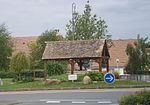24 Hours of Le Mans (motorcycle race)
Endurance motor racingMotorcycle racesMotorsport competitions in FranceSport in Le Mans

The 24 Heures Motos (often called in English the 24 Hours of Le Mans motorcycle race) is a motorcycle endurance race held annually since 1978 on the Bugatti Circuit, Le Mans, Sarthe, France. The race is organized by the Automobile Club de l'Ouest (ACO) and is part of the Endurance FIM World Championship.
Excerpt from the Wikipedia article 24 Hours of Le Mans (motorcycle race) (License: CC BY-SA 3.0, Authors, Images).24 Hours of Le Mans (motorcycle race)
Chemin de l'Ormeau de Vaux aux Hunaudières, Le Mans
Geographical coordinates (GPS) Address Nearby Places Show on map
Geographical coordinates (GPS)
| Latitude | Longitude |
|---|---|
| N 47.941666666667 ° | E 0.225 ° |
Address
Chemin de l'Ormeau de Vaux aux Hunaudières
Chemin de l'Ormeau de Vaux aux Hunaudières
72230 Le Mans
Pays de la Loire, France
Open on Google Maps









